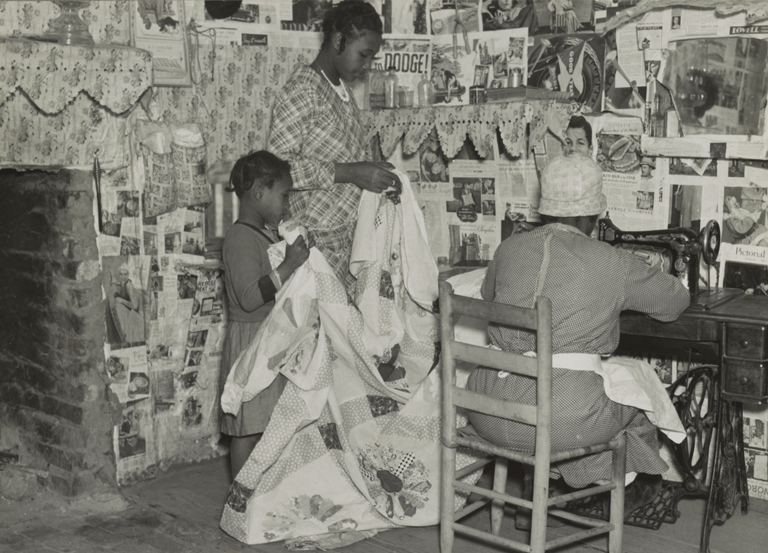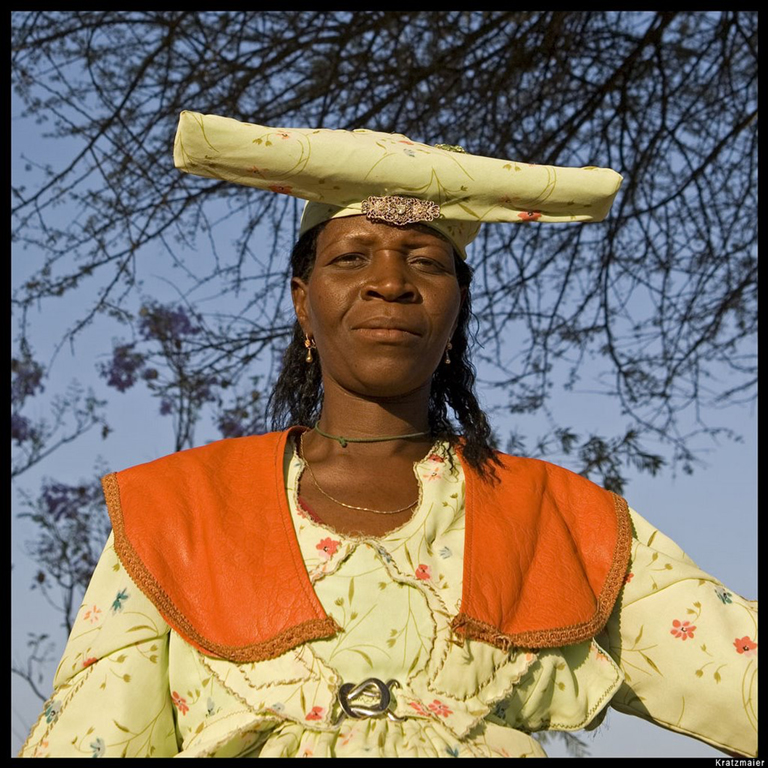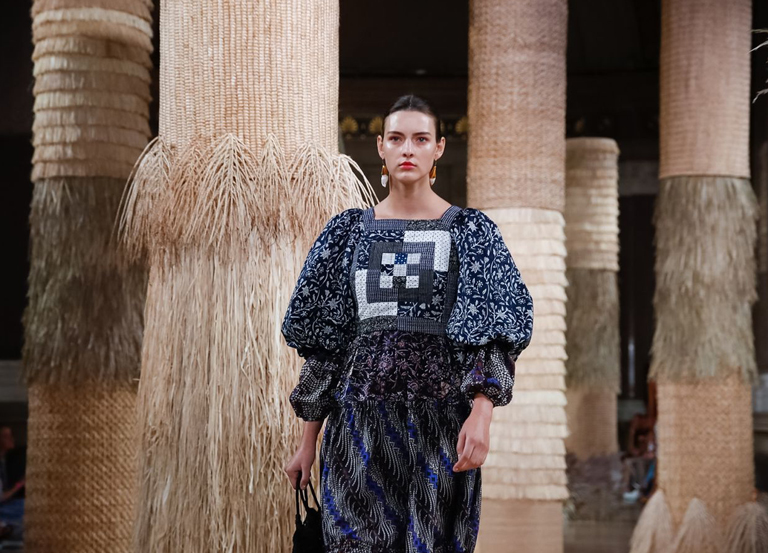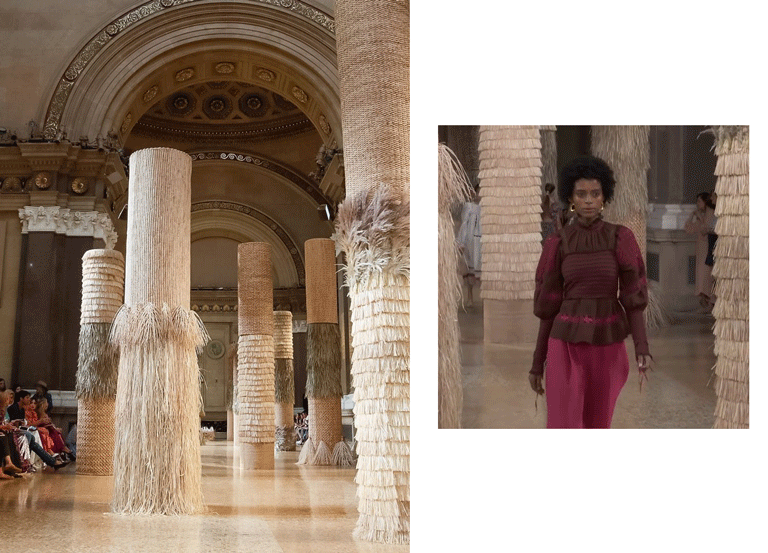Inspiration Done Right: Ulla Johnson Spring 2019
It's the first day of Spring 2019 New York Fashion Week and spirits are high. Street style is on and the shows are off to a start. It’s a fashion enthusiast holiday, so like the others I’m stalking The Shows as they go live, waiting for the coverage and photos. As the first day ends I am mesmerized by a collection with patterns clashing, crocheted pieces layered with flowing dresses, and diversity. Ulla Johnson’s Spring 2019 Collection was enchanting. In the Vogue review Johnson stated she was inspired by the Herero tribeswomen and quilters of Gee’s Bend. This caught my attention, so I went to find out, who and what inspired this collection.

About 117 people populate a small town in Wilcox County, Alabama along the river. The town sits at the bend of the river, giving it half of its name, Gee’s Bend. In the early 1800s Joseph Gee started a cotton plantation there, owning 18 slaves. In the mid- 1800s, Joseph Gee passed, leaving the land to nephews who then soon after sold it to another slave owner named Mark Pettway. He moved from North Carolina to Wilcox County, Alabama, bringing almost 100 slaves with him. Slaves lived there well after the abolishment of slavery working as sharecroppers. In the late 1800s, women of the community begin making quilts to use for warmth. They got their quilting fabrics from old clothing and scraps of material.

After slavery the land was sold to a landlord that didn’t keep up with the area and ran himself into debt. During the 1900s the town’s population dwindled. With few resources left after cattle and equipment was seized by people who the absentee landlord owed and a broken ferry system that transported people to the city, money was hard to come by. Also, this was during the time where the Civil Rights Movement was flowing into Alabama. Gee’s Bend got a visit from Martin Luther King, but many of the towns people said his visit did nothing for them, but it did birth the Freedom Quilting Bee.
In 1966, black women in the Wilcox County area decided to begin a cooperative to generate revenue into the area. Some visitors and activists recognized the quilts as a possible way for income also influencing this idea. It gained the attention of art collectors who traveled to Alabama to see the quilts and few eventually auctioned them off upstate. The quilts also caught the eye of Vogue, Sears, and Bloomingdales. This helped the sales of the quilts for the women of the Freedom Quilters Bee.

Bill Arnett, a historian, came to the community after he had seen a photograph of a quilt from Gee’s Bend. He noticed how beautiful these quilts were and some sold for over $1,000 at auctions. He named the ladies "Gee's Bend Quilters". "Until Bill came along he tol’ us we got artwork," a sweet, thick-accented Arlonzia Pettway said. "And I ain’ know what artwork was." And do not confuse the Gee's Bend Quiltmakers with the Freedom Quilting Bee, they were two separate groups, just with the same mission. A few women from Gee's Bend did join the Quilters Bee but not all.
The ladies’ quilts have gone on to be featured in museums of art in Boston, Houston, New York and even The Smithsonian in Washington, DC. The quilting tradition is still alive in the current generation of the Gee’s Bend descendants.



Above South Africa on the South Atlantic Ocean coast sits the country of Namibia. If you're familiar with African countries you'd know Namibia is known for their beautiful landscapes and large protected conservations. The people of Namibia walk the streets in normal fashion with the richest cultures but tragedy haunts their past.
A genocide largely silenced and unheard of occurred between Germans and the Nama and Herero people (tribes that lived in Namibia) during the early 1900s. In the late 1880s Germans ruled a colony in South West Africa that included a few tribes. The natives of the land rebelled but with little success. At the beginning of the 1900s German leaders of the colony and military decided it was time to take over. Land and cattle were taken into German possession soon after and anyone who rebelled was killed. They didn’t view the tribes as humans. Quoted from General Lothar von Trotha “A humane war cannot be waged against those who are not human.” They killed people, held them captive in camps, and even poisoned the waters nearby that would kill them if they drank it. Researchers estimated the population of the Herero people to be 80,000 before the genocide. By 1908 it was down to 15,000. A little over 80% of the population had been killed or dyed during flee. At the end when Germans felt satisfied with the “extermination” of original natives of the land, they kept the remaining Herero people in camps where they did slave labor.
Namibia didn’t gain independence as a country until 1990 where they detached from South Africa who had been going through apartheid. Today Namibians have their land and freedom back. While piecing their culture back together they decided to showcase their pride in a courageous way. They took some of what belonged to Germany.

Long dresses fitted under the breast, puffed shoulders, and bell flared to the floor matched by a horn shaped hat. Often a patchwork of fabrics for normal everyday wear or a solid color or fabric for special occasions, this is the Herero Dress. An iconic Victorian dress silhouette was adopted by the Herero women from the German women that once occupied their space.
Anthropologist Dr. Lutz Marten said the Herero people believe that “wearing the enemy's uniform will diminish their power and transfer some of their strength to the new wearer.”

The Herero dress is captivating to visitors of the country as it is worn in the highest heats but the women have no complaint. It is a symbol that they have not forgotten the genocide of their people. Germany has issued few half apologies as they try to look over the atrocity but the Herero people will never forget it.



You can see the geometric patterns in the tops and bodices of dresses referencing the Gee’s Bend Quiltmakers. Shaped ruffled shoulders hand-woven from raffia, a palm tree native to tropical African regions, was a play on the high puffed shoulders from the Herero dress; along with the patchwork of prints. When you know the inspiration behind something you look it differently. Not only was the collection still eye-catching; the looks now are strong and prideful. You can see struggle in the art but you feel the liberation of overcoming through the free-flowing dresses. That is a collection. That is influence done right.

*Photos of the show are from Vogue.com, WWD.com, and NowFashion.com.
READ MORE ON GEE'S BEND QUILTERS AND THE HERERO TRIBE
"The History of Gee's Bend, Alabama" by Kyes Stephens for Alabama Online Encyclopedia
"Herero and Nama Genocide"
"A Brutal Genocide in Colonial Africa Finally Gets its Deserved Recognition" by Daniel A. Gross for Smithsonian.com
"Costume drama: How Namibia's Herero tribe subverted the style diktats of their oppressors" by Peter Popham for The Independent
"Fabric of Their Lives" by Amei Wallach for Smithsonian Magazine
WATCH
Style Out There: Namibia: The Trauma and Triumph Of Herero Dresses
The Quiltmakers of Gee’s Bend via PBS
View the images and Vogue's review of Ulla Johnson Spring 2019 Collection here.
GEE’S BEND QUILTMAKERS

Carrying Water, Arthur Rothstein, 1937
About 117 people populate a small town in Wilcox County, Alabama along the river. The town sits at the bend of the river, giving it half of its name, Gee’s Bend. In the early 1800s Joseph Gee started a cotton plantation there, owning 18 slaves. In the mid- 1800s, Joseph Gee passed, leaving the land to nephews who then soon after sold it to another slave owner named Mark Pettway. He moved from North Carolina to Wilcox County, Alabama, bringing almost 100 slaves with him. Slaves lived there well after the abolishment of slavery working as sharecroppers. In the late 1800s, women of the community begin making quilts to use for warmth. They got their quilting fabrics from old clothing and scraps of material.

Sewing a Quilt, Arthur Rothstein, 1937
After slavery the land was sold to a landlord that didn’t keep up with the area and ran himself into debt. During the 1900s the town’s population dwindled. With few resources left after cattle and equipment was seized by people who the absentee landlord owed and a broken ferry system that transported people to the city, money was hard to come by. Also, this was during the time where the Civil Rights Movement was flowing into Alabama. Gee’s Bend got a visit from Martin Luther King, but many of the towns people said his visit did nothing for them, but it did birth the Freedom Quilting Bee.
In 1966, black women in the Wilcox County area decided to begin a cooperative to generate revenue into the area. Some visitors and activists recognized the quilts as a possible way for income also influencing this idea. It gained the attention of art collectors who traveled to Alabama to see the quilts and few eventually auctioned them off upstate. The quilts also caught the eye of Vogue, Sears, and Bloomingdales. This helped the sales of the quilts for the women of the Freedom Quilters Bee.

Crazy Quilt by Plummer T. Pettway and Two-Sided Quilt: "Pinwheel" Variation, And Blocks And Strips by Allie Pettway
Bill Arnett, a historian, came to the community after he had seen a photograph of a quilt from Gee’s Bend. He noticed how beautiful these quilts were and some sold for over $1,000 at auctions. He named the ladies "Gee's Bend Quilters". "Until Bill came along he tol’ us we got artwork," a sweet, thick-accented Arlonzia Pettway said. "And I ain’ know what artwork was." And do not confuse the Gee's Bend Quiltmakers with the Freedom Quilting Bee, they were two separate groups, just with the same mission. A few women from Gee's Bend did join the Quilters Bee but not all.
The ladies’ quilts have gone on to be featured in museums of art in Boston, Houston, New York and even The Smithsonian in Washington, DC. The quilting tradition is still alive in the current generation of the Gee’s Bend descendants.

Loretta Pettway, Matthew Arnett, 2002 and Bricklayer Quilt by her.

Housetop variation, Louisiana P. Bendolph
THE HERERO GENOCIDE AND DRESS

Herero Woman, Juan Kratzmaier, 2008
Above South Africa on the South Atlantic Ocean coast sits the country of Namibia. If you're familiar with African countries you'd know Namibia is known for their beautiful landscapes and large protected conservations. The people of Namibia walk the streets in normal fashion with the richest cultures but tragedy haunts their past.
A genocide largely silenced and unheard of occurred between Germans and the Nama and Herero people (tribes that lived in Namibia) during the early 1900s. In the late 1880s Germans ruled a colony in South West Africa that included a few tribes. The natives of the land rebelled but with little success. At the beginning of the 1900s German leaders of the colony and military decided it was time to take over. Land and cattle were taken into German possession soon after and anyone who rebelled was killed. They didn’t view the tribes as humans. Quoted from General Lothar von Trotha “A humane war cannot be waged against those who are not human.” They killed people, held them captive in camps, and even poisoned the waters nearby that would kill them if they drank it. Researchers estimated the population of the Herero people to be 80,000 before the genocide. By 1908 it was down to 15,000. A little over 80% of the population had been killed or dyed during flee. At the end when Germans felt satisfied with the “extermination” of original natives of the land, they kept the remaining Herero people in camps where they did slave labor.
Namibia didn’t gain independence as a country until 1990 where they detached from South Africa who had been going through apartheid. Today Namibians have their land and freedom back. While piecing their culture back together they decided to showcase their pride in a courageous way. They took some of what belonged to Germany.

Herero Woman in Patchwork Dress, Jim Naughten, 2012
Long dresses fitted under the breast, puffed shoulders, and bell flared to the floor matched by a horn shaped hat. Often a patchwork of fabrics for normal everyday wear or a solid color or fabric for special occasions, this is the Herero Dress. An iconic Victorian dress silhouette was adopted by the Herero women from the German women that once occupied their space.
Anthropologist Dr. Lutz Marten said the Herero people believe that “wearing the enemy's uniform will diminish their power and transfer some of their strength to the new wearer.”

Unknown picture and patchwork on Herero Dresses
The Herero dress is captivating to visitors of the country as it is worn in the highest heats but the women have no complaint. It is a symbol that they have not forgotten the genocide of their people. Germany has issued few half apologies as they try to look over the atrocity but the Herero people will never forget it.
ULLA JOHNSON SPRING 2019 COLLECTION

Ulla Johnson, designer of Ulla Johnson, has an eye for artisanal practices, no surprise that the Herero tribeswomen and the women of Gee’s Bend caught her eye. Her collections often include batik prints, a special wax-resistant dying technique derived from Indonesia use to create pattern fabrics. The brand is also known for the bohemian vibe it gives off with a mix of global influence.
Stating exact inspiration is not common during the fashion seasons. Inspiration from the history and cultures of African and African American people often go unstated. But to start off Fashion Month with exact locations and people who inspired a collection was refreshing. To see the influence placed into the collection where it doesn’t overpower the original aesthetic but drove the designer to push her talents is admirable. It is what fashion has been missing.


You can see the geometric patterns in the tops and bodices of dresses referencing the Gee’s Bend Quiltmakers. Shaped ruffled shoulders hand-woven from raffia, a palm tree native to tropical African regions, was a play on the high puffed shoulders from the Herero dress; along with the patchwork of prints. When you know the inspiration behind something you look it differently. Not only was the collection still eye-catching; the looks now are strong and prideful. You can see struggle in the art but you feel the liberation of overcoming through the free-flowing dresses. That is a collection. That is influence done right.

READ MORE ON GEE'S BEND QUILTERS AND THE HERERO TRIBE
"The History of Gee's Bend, Alabama" by Kyes Stephens for Alabama Online Encyclopedia
"Herero and Nama Genocide"
"A Brutal Genocide in Colonial Africa Finally Gets its Deserved Recognition" by Daniel A. Gross for Smithsonian.com
"Costume drama: How Namibia's Herero tribe subverted the style diktats of their oppressors" by Peter Popham for The Independent
"Fabric of Their Lives" by Amei Wallach for Smithsonian Magazine
WATCH
Style Out There: Namibia: The Trauma and Triumph Of Herero Dresses
The Quiltmakers of Gee’s Bend via PBS
View the images and Vogue's review of Ulla Johnson Spring 2019 Collection here.

Such an interesting blog post! love how empowering it is x
ReplyDeletehttp://www.lifeofacameo.com/